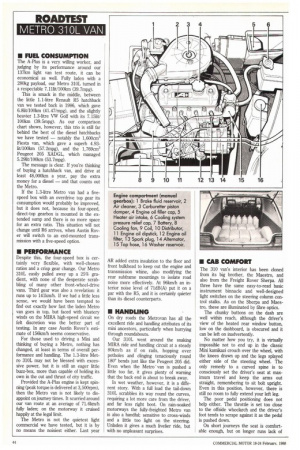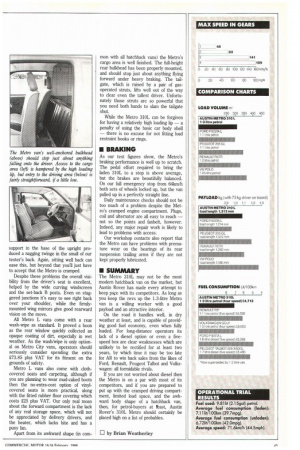ROADTEST METRO 310L VAN
Page 48

Page 49

If you've noticed an error in this article please click here to report it so we can fix it.
The A-Plus is a very willing worker, and judging by its performance around our 137km light van test route, it can be economical as well. Fully laden with a 280kg payload, our Metro 310L turned in a respectable 7.111it/100km (39.7mpg).
This is smack in the middle, between the little 1.1-litre Renault R5 hatchback van we tested back in 1986, which gave 6.8lit/100km (41.47/mpg), and the slightly heavier 1.3-litre VW Golf with its 7.151ft/ 100Iun (39.5mpg). As our comparison chart shows, however, this trio is still far behind the best of the diesel hatchbacks we have tested — notably the 1,600cm3 Fiesta van, which gave a superb 4.93lit/100km (57.2mpg), and the 1,769cm3 Peugeot 205 XADGL, which managed 5. 291ft./100km (53. 7mpg).
The message is clear. If you're thinking of buying a hatchback van, and drive at least 48,000km a year, pay the extra money for a diesel — and that counts out the Metro.
If the 1.3-litre Metro van had a fivespeed box with an overdrive top gear its consumption would probably be improved, but it does not, because its four-speed, direct-top gearbox is mounted in the extended sump and there is no more space for an extra ratio. This situation will not change until R6 arrives, when Austin Rover will switch to an end-mounted transmission with a five-speed option.
Despite this, the four-speed box is certainly very flexible, with well-chosen ratios and a crisp gear change. Our Metro 310L easily pulled away up a 25% gradient, with none of the desperate scrabbling of many other front-wheel-drive vans. Third gear was also a revelation: it runs up to 141km/h. If we had a little less sense, we would have been tempted to find out exactly how fast the laden Metro van goes in top, but faced with blustery winds on the MIRA high-speed circuit we felt discretion was the better part of testing. In any case Austin Rover's estimate of 156km/h seems conservative.
For those used to driving a Mini and thinking of buying a Metro, nothing has changed, at least in terms of overall performance and handling. The 1.3-litre Metro 310L may not be blessed with excessive power, but it is still an eager little buzz-box, more than capable of holding its own in the cut and thrust of city traffic.
Provided the A-Plus engine is kept spinning (peak torque is delivered at 3,500rpm), then the Metro van is not likely to disappoint on journey times. It scurried around our van route at an average of 71.6km/h fully laden; on the motorway it cruised happily at the legal limit.
The Metro is not the quietest light commercial we have tested, but it is by no means the noisiest either. Last year AR added extra insulation to the floor and front bulkhead to keep out the engine and transmission whine, also modifying the rear subframe mountings to isolate road noise more effectively. At 96km/h an interior noise level of 71dB(A) put it on a par with the R5, and it is certainly quieter than its diesel counterparts.
On dry roads the Metrovan has all the excellent ride and handling attributes of its mini ancestors, particularly when hurrying through roundabouts.
Our 310L went around the snaking MIRA ride and handling circuit at a steady 80km/h as if on rails, hopping over potholes and clinging tenaciously round 180° bends just like the Peugeot 205 did. Even when the Metro • van is pushed a little too far, it gives plenty of warning that the back end is about to break away.
In wet weather, however, it is a different story. With a MI load the tail-down 310L scrabbles its way round the curves, requiring a lot more care from the driver, and far less right boot. On rain-soaked motorways the fully-freighted Metro van is also a handful; sensitive to cross-winds and a little too light on the steering. Unladen it gives a much livelier ride, but with no unpleasant surprises. The 310 van's interior has been cloned from its big brother, the Maestro, and also from the Freight Rover Sherpa. All three have the same easy-to-read basic instrument binnacle and well-designed light switches on the steering column control stalks. As on the Sherpa and Maestro, these are illuminated by fibre optics.
The chunky buttons on the dash are well within reach, although the driver's view of the heated rear window button, low on the dashboard, is obscured and it can be left on inadvertently.
No matter how you try, it is virtually impossible not to end up in the classic Mini kamikazi crouch over the wheel, with the knees drawn up and the legs splayed either side of the steering wheel. The only remedy to a curved spine is to consciously set the driver's seat at maximum travel and keep the arms out straight, remembering to sit bolt upright. Even in this position, however, there is still no room to fully extend your left leg.
The poor pedal positioning does not help either. The throttle is set too close to the offside wheelarch and the driver's foot tends to scrape against it as the pedal is pushed down.
On short journeys the seat is comfortable enough, but on longer runs lack of support in the base of the upright produced a nagging twinge in the small of our tester's back. Again, sitting well back can ease this, but beyond that you'll just have to accept that the Metro is cramped.
Despite these problems the overall visibility from the driver's seat is excellent, helped by the wide curving windscreen and the set-back B posts. Even on staggered junctions it's easy to see right back over your shoulder, while the firmlymounted wing mirrors give good rearward vision on the move.
All Metro L vans come with a rear wash-wipe as standard. It proved a boon as the rear window quickly collected an opaque coating of dirt, especially in wet weather. As the wash/wipe is only optional on Metro City vans, operators should seriously consider spending the extra £73.85 plus VAT for its fitment on the grounds of safety.
Metro L vans also come with clothcovered seats and carpeting, although if you are planning to wear mud-caked boots then the no-extra-cost option of vinylcovered seats is more practical, along with the fitted rubber floor covering which costs 225 plus VAT. Our only real moan about the forward compartment is the lack of any real storage space, which will not be appreciated by delivery drivers, and the heater, which lacks bite and has a puny fan.
Apart from its awkward shape (in com mon with all hatchback vans) the Metro's cargo area is well finished. The full-height rear bulkhead has been properly mounted, and should stop just about anything flying forward under heavy braking. The tailgate, which is raised by a pair of gasoperated struts, lifts well out of the way to clear even the tallest driver. Unfortunately those struts are so powerful that you need both hands to slam the tailgate shut.
While the Metro 310L can be forgiven for having a relatively high loading lip — a penalty of using the basic car body shell — there is no excuse for not fitting load restraint hooks or rings.
As our test figures show, the Metro's braking performance is well up to scratch. The pedal effort required to bring the laden 310L to a stop is above average, but the brakes are beautifully balanced. On our full emergency stop from 64km/h both sets of wheels locked up, but the van pulled up in a perfectly straight line.
Daily maintenance checks should not be too much of a problem despite the Metro's cramped engine compartment. Plugs, coil and alternator are all easy to reach — not so the points and fanbelt, however. Indeed, any major repair work is likely to lead to problems with access.
Our workshop contacts also report that the Metro can have problems with premature wear on the bearings of its rear suspension trailing arms if they are not kept properly lubricated.
The Metro 310L may not be the most modern hatchback van on the market, but Austin Rover has made every attempt to keep pace with its competitors. As long as you keep the revs up the 1.3-litre Metro van is a willing worker with a good payload and an attractive interior.
On the road it handles well, in dry weather at least, and is capable of providing good fuel economy, even when fully loaded. For long-distance operators its lack of a diesel option or even a fivespeed box are clear weaknesses which are unlikely to be rectified for at least two years, by which time it may be too late for AR to win back sales from the likes of Ford, Renault, Peugeot Talbot and Volkswagen: all formidable rivals.
If you are not worried about diesel then the Metro is on a par with most of its competitors, and if you are prepared to put up with the cramped driving compartment, limited load space, and the awkward body shape of a hatchback van, then, for petrol-buyers at past, Austin Rover's 310L Metro should certainly be placed high on a list of probables.
























































































